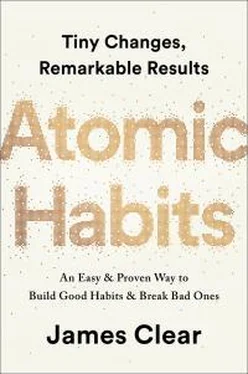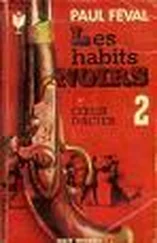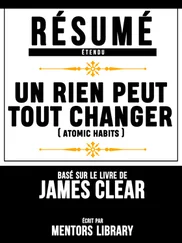The tighter we cling to an identity, the harder it becomes to grow beyond it.
Conclusion The Secret to Results That Last
THERE IS AN ancient Greek parable known as the Sorites Paradox,* which talks about the effect one small action can have when repeated enough times. One formulation of the paradox goes as follows: Can one coin make a person rich? If you give a person a pile of ten coins, you wouldn’t claim that he or she is rich. But what if you add another? And another? And another? At some point, you will have to admit that no one can be rich unless one coin can make him or her so.
We can say the same about atomic habits. Can one tiny change transform your life? It’s unlikely you would say so. But what if you made another? And another? And another? At some point, you will have to admit that your life was transformed by one small change.
The holy grail of habit change is not a single 1 percent improvement, but a thousand of them. It’s a bunch of atomic habits stacking up, each one a fundamental unit of the overall system.
In the beginning, small improvements can often seem meaningless because they get washed away by the weight of the system. Just as one coin won’t make you rich, one positive change like meditating for one minute or reading one page each day is unlikely to deliver a noticeable difference.
Gradually, though, as you continue to layer small changes on top of one another, the scales of life start to move. Each improvement is like adding a grain of sand to the positive side of the scale, slowly tilting things in your favor. Eventually, if you stick with it, you hit a tipping point. Suddenly, it feels easier to stick with good habits. The weight of the system is working for you rather than against you.
Over the course of this book, we’ve looked at dozens of stories about top performers. We’ve heard about Olympic gold medalists, award-winning artists, business leaders, lifesaving physicians, and star comedians who have all used the science of small habits to master their craft and vault to the top of their field. Each of the people, teams, and companies we have covered has faced different circumstances, but ultimately progressed in the same way: through a commitment to tiny, sustainable, unrelenting improvements.
Success is not a goal to reach or a finish line to cross. It is a system to improve, an endless process to refine. In Chapter 1, I said, “If you’re having trouble changing your habits, the problem isn’t you. The problem is your system. Bad habits repeat themselves again and again not because you don’t want to change, but because you have the wrong system for change.”
As this book draws to a close, I hope the opposite is true. With the Four Laws of Behavior Change, you have a set of tools and strategies that you can use to build better systems and shape better habits. Sometimes a habit will be hard to remember and you’ll need to make it obvious . Other times you won’t feel like starting and you’ll need to make it attractive . In many cases, you may find that a habit will be too difficult and you’ll need to make it easy . And sometimes, you won’t feel like sticking with it and you’ll need to make it satisfying .
Behaviors are effortless here.
Behaviors are difficult here.
Obvious
Invisible
Attractive
Unattractive
Easy
Hard
Satisfying
Unsatisfying
You want to push your good habits toward the left side of the spectrum by making them obvious, attractive, easy, and satisfying. Meanwhile, you want to cluster your bad habits toward the right side by making them invisible, unattractive, hard, and unsatisfying.
This is a continuous process. There is no finish line. There is no permanent solution. Whenever you’re looking to improve, you can rotate through the Four Laws of Behavior Change until you find the next bottleneck. Make it obvious. Make it attractive. Make it easy. Make it satisfying. Round and round. Always looking for the next way to get 1 percent better.
The secret to getting results that last is to never stop making improvements. It’s remarkable what you can build if you just don’t stop. It’s remarkable the business you can build if you don’t stop working. It’s remarkable the body you can build if you don’t stop training. It’s remarkable the knowledge you can build if you don’t stop learning. It’s remarkable the fortune you can build if you don’t stop saving. It’s remarkable the friendships you can build if you don’t stop caring. Small habits don’t add up. They compound.
That’s the power of atomic habits. Tiny changes. Remarkable results.
Appendix
What Should You Read Next?
THANK YOU SO much for taking the time to read this book. It has been a pleasure sharing my work with you. If you are looking for something to read next, allow me to offer a suggestion.
If you enjoyed Atomic Habits , then you may like my other writing as well. My latest articles are sent out in my free weekly newsletter. Subscribers are also the first to hear about my newest books and projects. Finally, in addition to my own work, each year I send out a reading list of my favorite books from other authors on a wide range of subjects.
You can sign up at:
jamesclear.com/newsletter
Little Lessons from the Four Laws
IN THIS BOOK, I have introduced a four-step model for human behavior: cue, craving, response, reward. This framework not only teaches us how to create new habits but also reveals some interesting insights about human behavior.
Problem phase
1. Cue
2. Craving
Solution phase
3. Response
4. Reward
In this section, I have compiled some lessons (and a few bits of common sense) that are confirmed by the model. The purpose of these examples is to clarify just how useful and wide-ranging this framework is when describing human behavior. Once you understand the model, you’ll see examples of it everywhere.
Awareness comes before desire.A craving is created when you assign meaning to a cue. Your brain constructs an emotion or feeling to describe your current situation, and that means a craving can only occur after you have noticed an opportunity.
Happiness is simply the absence of desire.When you observe a cue, but do not desire to change your state, you are content with the current situation. Happiness is not about the achievement of pleasure (which is joy or satisfaction), but about the lack of desire. It arrives when you have no urge to feel differently. Happiness is the state you enter when you no longer want to change your state.
However, happiness is fleeting because a new desire always comes along. As Caed Budris says, “Happiness is the space between one desire being fulfilled and a new desire forming.” Likewise, suffering is the space between craving a change in state and getting it.
It is the idea of pleasure that we chase.We seek the image of pleasure that we generate in our minds. At the time of action, we do not know what it will be like to attain that image (or even if it will satisfy us). The feeling of satisfaction only comes afterward. This is what the Austrian neurologist Victor Frankl meant when he said that happiness cannot be pursued, it must ensue. Desire is pursued. Pleasure ensues from action.
Peace occurs when you don’t turn your observations into problems.The first step in any behavior is observation. You notice a cue, a bit of information, an event. If you do not desire to act on what you observe, then you are at peace.
Читать дальше




![Джеймс Клир - Атомные привычки [Как приобрести хорошие привычки и избавиться от плохих]](/books/403243/dzhejms-klir-atomnye-privychki-kak-priobresti-horosh-thumb.webp)



